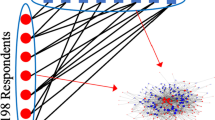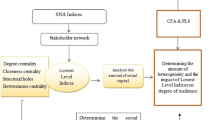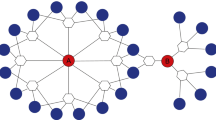Abstract
The objective of this study is to examine the properties of actor collaboration networks and to analyze how they influence the coordination of hazard mitigation in resilience planning in Harris County, Texas. Effective resilience planning can only be achieved through the collective actions of various actors and the network structures unfold the collaboration among the actors. Understanding the structural properties of actor collaboration networks for hazard mitigation may hold the key to understanding and improving the resilience planning process. To this end, after Hurricane Harvey, we administered a stakeholder survey to actors in various urban sectors involved in hazard mitigation (e.g., flood control, transportation, and emergency response). The survey aimed to capture actor collaboration networks for hazard mitigation in Harris County, Texas prior to Harvey. The collaboration represents that the survey respondents worked with the actors in the survey roster for hazard mitigation. We asked the respondents the frequency of the collaboration in the survey (e.g., yearly, monthly, weekly and daily). We examined three network structural properties to study actor positions in the network: degree centrality, boundary spanners, and core-periphery structure, because degree centrality could indicate what actors had more collaborations; boundary spanners could reveal what actors were in strategic positions to connect otherwise separate actors; and core-periphery structure could identify what actors formed the core of actor collaboration network for hazard mitigation and whether the core was composed of actors from diverse sectors. The results showed: (1) governmental actors from different sectors had high degree centrality and betweenness centrality, which indicated that governmental actors had a more influential role in coordination and information dissemination in hazard mitigation planning and implementation; and (2) fewer flood control and non-governmental actors were at the core of the actor collaboration networks, which reduced the extent of hazard mitigation coordination. The results identify potential influential actors (such as City of Houston, Harris County, and Houston–Galveston Area Council) in coordination of hazard mitigation and yield recommendations for increased actor network cohesion for better coordination of hazard mitigation across diverse sectors in resilience planning.









Similar content being viewed by others
Notes
We translated the cores to undirected networks when we calculated core densities. Due to the nature of the survey instrument, another direction would not be possible to identify. It would highly undervalue the core densities (half), if the cores were kept as directed networks when calculated the core density.
References
Abbasi A (2014) Link formation pattern during emergency response network dynamics. Nat Hazards 71(3):1957–1969
Aral S, Van Alstyne M (2011) The diversity-bandwidth trade-off. Am J Soc 117:90–171
Bastos M, McRoberts N, Piccardi C, Lubell M, Levy M (2017) Core-periphery or decentralized? Topological shifts of specialized information on Twitter. Soc Netw 52:282–293
Berke P (2019) Why is Houston so vulnerable to flooding? Retrieved from: https://hazards.colorado.edu/news/research-counts/part-i-why-is-houston-so-vulnerable-to-flooding.
Berke P, Newman G, Lee J, Combs T, Kolosna C, Salvesen D (2015) Evaluation of networks of plans and vulnerability to hazards and climate change: a resilience scorecard. J Am Plan Assoc 81(4):287–302
Berke PR, Malecha ML, Yu S, Lee J, Masterson JH (2019) Plan integration for resilience scorecard: evaluating networks of plans in six US coastal cities. J Environ Plan Manage 62(5):901–920
Berz G, Kron W, Loster T, Rauch E, Schimetschek J, Schmieder J, Siebert A, Smolka A, Wirtz A (2001) World map of natural hazards - a global view of the distribution and intensity of significant exposures. Nat Hazards 23(2–3):443–465
Bodin Ö (2017) Collaborative environmental governance: achieving collective action in social-ecological systems. Science, 357(6352).
Borgatti SP (1995) Centrality and AIDS. Connections 18(1):112–114
Borgatti SP (2005) Centrality and network flow. Soc Netw 27(1):55–71
Borgatti SP (2009). 2-Mode concepts in social network analysis. In: Encyclopedia of complexity and system science, vol 6, pp 8279-8291
Borgatti SP, Everett MG (2000) Models of core/periphery structures. Soc Netw 21(4):375–395
Bourgeois M, Friedkin NE (2001) The distant core: Social solidarity, social distance and interpersonal ties in core-periphery structures. Soc Netw 23(4):245–260
Burby RJ (2003) Making plans that matter: Citizen involvement and government action. J Am Plan Assoc 69(1):33–49
Creswick N, Westbrook JI (2010) Social network analysis of medication advice-seeking interactions among staff in an Australian hospital. Int J Med Inf 79(6):e116–e125
Cucuringu M, Rombach P, Lee SH, Porter MA (2016) Detection of core-periphery structure in networks using spectral methods and geodesic paths. Eur J Appl Math 27(6):846–887
Da Silva MR, Ma H, Zeng AP (2008) Centrality, network capacity, and modularity as parameters to analyze the core-periphery structure in metabolic networks. Proc IEEE 96(8):1411–1420
Dong S, Li Q, Farahmand H, Mostafavi A, Berke P, Vedlitz A (2020) Institutional connectedness in resilience planning and management of interdependent infrastructure systems. J Manage Eng. https://doi.org/10.1061/(ASCE)ME.1943-5479.00008
Doreian P (1985) Structural equivalence in a psychology journal network. J Am Soc Inf Sci 36(6):411–417
Doreian P, Conti N (2012) Social context, spatial structure and social network structure. Soc Netw 34(1):32–46
Dyckman CS (2018) Planning without the planners: South Carolina’s Section 319 local watershed planning process. Environ Sci Policy 89:126–141
Fan C, Zhang C, Mostafavi A (2018) Meta-network framework for analyzing disaster management system-of-systems. In: 2018 13th system of systems engineering conference, SoSE 2018, pp372–378
Farahmand H, Dong S, Mostafavi A, Berke PR, Woodruff SC, Hannibal B, Vedlitz A (2020) Institutional congruence for resilience management in interdependent infrastructure systems. Int J Disast Risk Reduct 46:101515
Feiock RC (2013) The institutional collective action framework. Policy Stud J 41(3):397–425
Freeman LC (1978) Centrality in social networks conceptual clarification. Soc Netw 1(3):215–239
Gajewski S, Bell H, Lein L, Angel RJ (2011) Complexity and instability: The response of nongovernmental organizations to the recovery of Hurricane Katrina survivors in a host community. Nonprofit Volunt Sector Quart 40(2):389–403
Gibbons DE (2004) Network structure and innovation ambiguity effects on diffusion in dynamic organizational fields. Acad Manag J 47(6):938–951
Godschalk DR (2003) Urban hazard mitigation: creating resilient cities. Nat Hazards Rev 4(3):136–143
Granovetter M (1983) The strength of weak ties: a network theory revisited. Soc Theory 1:201
Hannibal B, Ono H (2017) Relationships of collapse: Network brokerage, opportunism and fraud in financial markets. Int J Soc Econ 44(12):2097–2111
Hawe P, Ghali L (2008) Use of social network analysis to map the social relationships of staff and teachers at school. Health Educ Res 23(1):62–69
Holme P (2005) Core-periphery organization of complex networks. Phys Rev E: Statist Nonlinear Soft Matter Phys 72(4):46111
Hughes TP, Baird AH, Bellwood DR, Card M, Connolly SR, Folke C, Grosberg R, Hoegh-Guldberg O, Jackson JBC, Kleypas J, Lough JM, Marshall P, Nyström M, Palumbi SR, Pandolfi JM, Rosen B, Roughgarden J (2003) Climate change, human impacts, and the resilience of coral reefs. Science
Kapucu N (2005) Interorganizational coordination in dynamic context: networks in emergency response management. Connections 26(2):33–48
Kapucu N, Van Wart M (2006) The evolving role of the public sector in managing catastrophic disasters: Lessons learned. Administration and Society
Kotani H, Yokomatsu M (2016) Natural disasters and dynamics of ‘a paradise built in hell’: a social network approach. Nat Hazards 84(1):309–333
Larsen AG, Ellersgaard CH (2017) Identifying power elites—k-cores in heterogeneous affiliation networks. Soc Netw 50:55–69
Lazega E, Burt RS (1995) Structural holes: the social structure of competition. Revue Française de Sociologie. Harvard University Press, Cambridge
Li Q, Dong S, Mostafavi A (2019) Modeling of inter-organizational coordination dynamics in resilience planning of infrastructure systems: a multilayer network simulation framework. PLoS ONE 14(11)
Li Q, Dong S, Mostafavi A (2020) Metanetwork framework for analysis of actor-plan-task-infrastructure networks in resilience planning and management. Nat Hazards Rev 21(2)
Long JC, Cunningham FC, Braithwaite J (2013) Bridges, brokers and boundary spanners in collaborative networks: a systematic review. BMC Health Serv Res 13(1).
Lyles LW, Berke P, Smith G (2014) Do planners matter? Examining factors driving incorporation of land use approaches into hazard mitigation plans. J Environ Plan Manage 57(5):792–811
Malecha ML, Brand AD, Berke PR (2018) Spatially evaluating a network of plans and flood vulnerability using a plan integration for resilience scorecard: a case study in Feijenoord District, Rotterdam, the Netherlands. Land Use Policy 78:147–157
Masterson JH, Peacock WG, Van Zandt SS, Grover H, Schwarz LF, Cooper JT (2014) Planning for community resilience: a handbook for reducing vulnerability to disasters. Island Press, Washington, DC
Matyas CJ, Silva JA (2013) Extreme weather and economic well-being in rural Mozambique. Nat Hazards 66(1):31–49
METRO (1969) Regional population growth.” Statistical bulletin (Metropolitan Life Insurance Company)
Milallos M (2013) Building Resilience, social capital in post-disaster recovery: Daniel Aldrich (Chicago: The University of Chicago Press, 2012). Journal of Contemporary Asia, University of Chicago Press.
National Research Council (2012) Disaster resilience: A national imperative. The National Academies Press.
Newman M (2018). Networks. Oxford University Press.
NOAA & NHC (2018) Costliest U.S. tropical cyclones tables updated. NOAA Technical Memorandum NWS NHC-6, 3
Opdyke A, Lepropre F, Javernick-Will A, Koschmann M (2017) Inter-organizational resource coordination in post-disaster infrastructure recovery. Construct Manage Econ 35(8–9):514–530
Opsahl T, Agneessens F, Skvoretz J (2010) Node centrality in weighted networks: generalizing degree and shortest paths. Soc Netw 32(3):245–251
Phelps C, Heidl R, Wadhwa A (2012) Knowledge, networks, and knowledge networks: a review and research agenda. J Manage 38(4):1115–1166
Rajput AA, Li Q, Zhang C, Mostafavi A (2020) Temporal network analysis of inter-organizational communications on social media during disasters: a study of Hurricane Harvey in Houston. Int J Disaster Risk Reduct 46(Under Review)
Rombach MP, Porter MA, Fowler JH, Mucha PJ (2014) Core-periphery structure in networks. SIAM J Appl Math 74(1):167–190
Rossa FD, Dercole F, Piccardi C (2013) Profiling core-periphery network structure by random walkers. Sci Rep 3:1–5
Sadri AM, Ukkusuri SV, Lee S, Clawson R, Aldrich D, Nelson MS, Seipel J, Kelly D (2018) The role of social capital, personal networks, and emergency responders in post-disaster recovery and resilience: a study of rural communities in Indiana. Nat Hazards 90(3):1377–1406
Schilling MA, Phelps CC (2007) Interfirm collaboration networks: The impact of large-scale network structure on firm innovation. Manage Sci 53(7):1113–1126
Scholz JT, Berardo R, Kile B (2008) Do networks solve collective action problems? Credibility, search, and collaboration. J Polit 70(2):393–406
Scott J, Carrington P, Borgatti SP, Halgin DS (2015) Analyzing affiliation networks. SAGE Handbook Soc Netw Anal 1:417–433
Shilcutt K, Asgarian R (2017) The deliberate flooding of west houston. Issue of Houstonia, https://www.houstoniamag.com/news-and-city-life/20.
Soldz S, Andersen LL (2012) Expanding subjectivities: introduction to the special issue on ‘new directions in psychodynamic research. J Res Pract 8(2):123–132
Stone DH, Brewster DC, Kwolek CJ, LaMuraglia GM, Conrad MF, Chung TK, Cambria RP (2006) Stent-graft versus open-surgical repair of the thoracic aorta: Mid-term results. J Vascular Surg, pp 188–1197
Uzzi B (1997) Social structure and competition in interfirm networks: The paradox of embeddedness. Adm Sci Q 42(1):35–67
Uzzi B, Spiro J (2005) Collaboration and creativity: The small world problem. Am J Sociol 111(2):447–504
Wiki (2019) Disasters in Houston. Retrieved from: https://en.wikipedia.org/wiki/Timeline_of_Houston.
Woodruff SC, Regan P (2019) Quality of national adaptation plans and opportunities for improvement. Mitig Adapt Strat Glob Change 24(1):53–71
Zambrano Leal A (2012) Sociedad de control y profesión docente. Las imposturas de un discurso y la exigencia de una nueva realidad. Antimicrob Agents Chemother 95:45–52
Zhang X, Martin T, Newman MEJ (2015) Identification of core-periphery structure in networks. Phys Rev E: Stat, Nonlin, Soft Matter Phys 91(3):32803
Zhu J, Mostafavi A (2016) Metanetwork framework for integrated performance assessment under uncertainty in construction projects. J Comput Civ Eng 31(1):04016042
Acknowledgements
The authors would like to acknowledge funding support from the National Science Foundation RAPID project # (1760258): ‘RAPID: Assessment of Risks and Vulnerability in Coupled Human-Physical Networks of Houston's Flood Protection, Emergency Response, and Transportation Infrastructure in Harvey.’ CRISP project # (1832662): ‘Anatomy of Coupled Human-Infrastructure Systems Resilience to Urban Flooding: Integrated Assessment of Social, Institutional, and Physical Networks.’ Publication supported in part by an Institutional Grant (NA18OAR4170088) to the Texas Sea Grant College Program from the National Sea Grant Office, National Oceanic and Atmospheric Administration, US Department of Commerce. Any opinions, findings, and conclusion or recommendations expressed in this research are those of the authors and do not necessarily reflect the view of the funding agencies. Also, the authors would like to acknowledge Nandita Chaudhuri, Carol Goldsmith, Lisa A Halperin, Kirby Goidel, Steven Vanoye, Anthony S Jackson, Matthew Malecha, and Baiherula Abula for their help with data collection.
Author information
Authors and Affiliations
Corresponding author
Additional information
Publisher's Note
Springer Nature remains neutral with regard to jurisdictional claims in published maps and institutional affiliations.
Electronic supplementary material
Below is the link to the electronic supplementary material.
Rights and permissions
About this article
Cite this article
Li, Q., Hannibal, B., Mostafavi, A. et al. Examining of the actor collaboration networks around hazard mitigation: a hurricane harvey study. Nat Hazards 103, 3541–3562 (2020). https://doi.org/10.1007/s11069-020-04142-1
Received:
Accepted:
Published:
Issue Date:
DOI: https://doi.org/10.1007/s11069-020-04142-1




